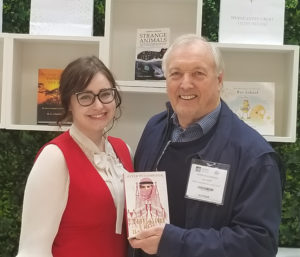Authors at the London Book Fair
March 23, 2019

I have just returned from the London Book Fair. It was a great experience, as many of you will know if you’ve attended it. The Fair is an annual gathering of people and companies in the global book trade. This year’s Market Focus was Indonesia.
Indonesia is a nation of 264 million people, which makes it the world’s 4th largest country. The good news for authors is that the adult literacy rate in Indonesia is over 95%. That’s up from 67% in 1980. For the under 24-year-olds, it’s 99%.
That’s good news because high and rising literacy rates are closely correlated with the development of reading skills and ultimately drive the demand for books — whether print, audio or e-books. Even though the English language market there is limited, increasing numbers of translations are being made to serve local demand.
At the Indonesian Pavilion, at this year’s London Book Fair, there was a constant buzz of excitement. Judging by what appeared to be some intense business meetings taking place, it looked very much a commercial success too.
What’s happening in Indonesia is mirrored in many other emerging nations.
Against this backdrop, it is relevant to ask some sensitive questions. For example, how multi-cultured is our writing? Obviously, cultures differ dramatically around the world. They’re not always compatible. Do books which are authored in the West successfully cross cultural lines? By many accounts, the answer is a qualified ‘yes’.
We all remember The Adventures of Pinocchio, as readers or as childhood listeners. Probably both! It was written by Italian Carlos Collodi in the 1880s. This well-loved story has been translated into more than 300 languages. Antoine de Saint-Exupéry’s 1943 classic The Little Prince has had similar success abroad. Lewis Carroll’s 1871 Through the Looking-Glass has been translated into more than 65 languages. There are many other examples.
Several literary works originating in Chinese, Japanese, Sanskrit and Tamil, for example, also have been widely translated. One of the oldest, Laozi’s Tao Te Ching written around 400 BCE, has been translated into Western languages more than 250 times.
Not all successes are ‘old’. J.K. Rowling’s fantastically successful Harry Potter books have been translated into more than 80 languages. John Boyne, author of the 2006 bestseller The Boy in the Striped Pyjamas, has novels published in over 50 languages. Dan Brown’s The Da Vinci Code can be found in over 40 languages. Of course, many of these titles were given a strong circulation boost by the movie industry.
What does all this mean for up-and-coming authors?
One conclusion I took away from various attendees, and particularly authors, at the London Book Fair is this: if a book is a ‘long seller’, not just a ‘best seller’, typically there will be few cultural barriers to its success.
That speaks to the old adage of successful books being ‘about memorable characters doing fascinating things’.
Now there’s a challenge for all of us.
